Under the immense Christ the Redeemer statue that overlooks Rio de Janeiro and its picturesque Guanabara Bay, dozens of tourists jockey for position to get selfies with the stunning panoramic view illuminated by the setting sun.
A tangle of arms and selfie sticks are lifted for solo shots, couple snaps, family photos. Getting the perfect picture with the statue or Sugarloaf Mountain in the background is the goal.
The only definite fail? Ending up with other tourists taking selfies in the frame.
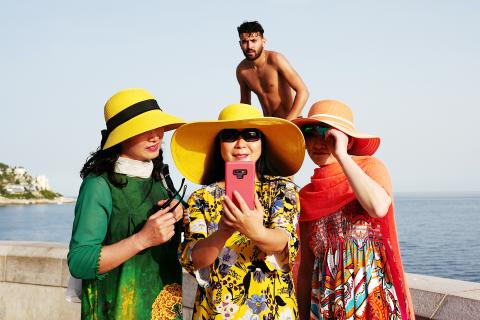
Photo: AFP
Brazil is a selfie-mad country. But it is hardly alone.
Around the globe, selfie culture has become a facet of daily life. Social media sites are flooded with pictures, and tourist attractions are overrun with those seeking selfie nirvana.
In some cases, that quest for the ideal happy snap has been deadly, when amateur photographers take the hobby too far. For celebrities, it can be a moneymaker.
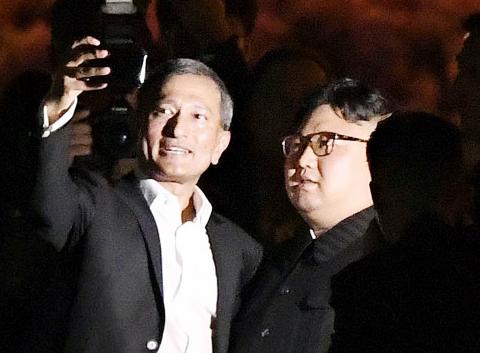
Photo: EPA
But for the average tourist, it’s a way to make memories.
Philippe, a young French engineer on holiday in Brazil who has Christ-like long hair, positions himself in front of the imposing Christ the Redeemer statue, an Art Deco work made of reinforced concrete and soapstone.
“My colleagues laughed, saying I look like Jesus. So I needed to take a selfie to send them,” he said.
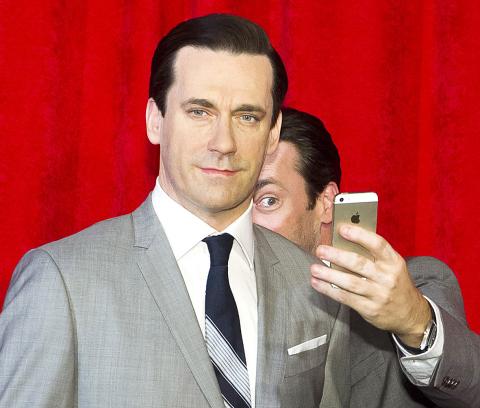
Photo: AP
But he isn’t all in on the idea.
“On social media, it can give a false impression. People only post pictures of beautiful things — the sun, Rio, the beach,” he said. “People end up getting depressed because they have the idea that their life is crappy.”
For Brazilian Daniela Lemes, taking selfies is “a happy moment, shared with family... in marvelous places like this one.”
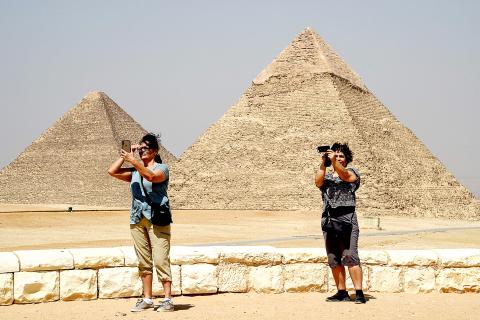
Photo: AFP
On the other side of Rio, at the waterfront Museum of Tomorrow, aesthetician Tatiana da Silva de Paula admits she takes 100 to 200 selfies a day.
“First I take some to see how I look. Then I post them on social media for my friends and family,” she said.
SELFIE WARS
About 9,000km away, in the heart of Rome, the Trevi Fountain is the must-have selfie spot.
Sarah and Fivos, a British couple from Manchester who came to the Eternal City to celebrate their 10th wedding anniversary, were part of the selfie scrum.
“We are happy with the selfie we took, but with so many people, you have to wait for the right moment to get the good shot with no people in the frame,” said Fivos.
Nearby, Elia and Chiara, two young Italians, took a selfie with their parents in the background... taking a selfie.
On this day, as on most days, there is such a huge crowd at the fountain — immortalized by Federico Fellini in the film La Dolce Vita — that tensions can mount.
In August last year, police had to separate two groups of tourists who had come to blows when they wanted to take a selfie at the same spot.
In Athens, even celebrities join the millions of tourists seeking romantic mementos. Facebook founder Mark Zuckerberg showed up at the Acropolis with his wife in May, after music legend Paul McCartney did the same.
PRACTICALLY A NATIONAL SPORT
In Egypt, before the Great Pyramid outside Cairo — the last of the ancient Seven Wonders of the World still standing — Bangladeshi tourist Sheila Ahmed uses her smartphone to do as so many have done before her.
“Generally, I am not a fan of selfies but it’s easier to just hang up your phone and take a picture of yourself at whatever place you want,” she said. “Especially here I am in front of the Great Pyramid — where would I want to take a selfie if not here?”
In the US, at Mather Point on the majestic Grand Canyon’s south rim, picture-taking is constant, but some go to extremes — and the very edge of the cliff.
“We can see well enough from here,” British tourist Kathryn Kelly said, looking at a woman in an especially risky spot. “I don’t see the point stepping closer to the edge.”
In South Korea, taking selfies is practically a national sport. To mark his 100 days in office, President Moon Jae-in shot a selfie video message.
North Korea seems to be the last place on Earth immune from selfie fever, where people prefer more traditional pictures.
Nevertheless, the country’s leader Kim Jong-un has posed for two selfies — with a Singaporean minister and a Russian journalist.

When the South Vietnamese capital of Saigon fell to the North Vietnamese forces 50 years ago this week, it prompted a mass exodus of some 2 million people — hundreds of thousands fleeing perilously on small boats across open water to escape the communist regime. Many ultimately settled in Southern California’s Orange County in an area now known as “Little Saigon,” not far from Marine Corps Base Camp Pendleton, where the first refugees were airlifted upon reaching the US. The diaspora now also has significant populations in Virginia, Texas and Washington state, as well as in countries including France and Australia.

On April 17, Chinese Nationalist Party (KMT) Chairman Eric Chu (朱立倫) launched a bold campaign to revive and revitalize the KMT base by calling for an impromptu rally at the Taipei prosecutor’s offices to protest recent arrests of KMT recall campaigners over allegations of forgery and fraud involving signatures of dead voters. The protest had no time to apply for permits and was illegal, but that played into the sense of opposition grievance at alleged weaponization of the judiciary by the Democratic Progressive Party (DPP) to “annihilate” the opposition parties. Blamed for faltering recall campaigns and faced with a KMT chair

Article 2 of the Additional Articles of the Constitution of the Republic of China (中華民國憲法增修條文) stipulates that upon a vote of no confidence in the premier, the president can dissolve the legislature within 10 days. If the legislature is dissolved, a new legislative election must be held within 60 days, and the legislators’ terms will then be reckoned from that election. Two weeks ago Taipei Mayor Chiang Wan-an (蔣萬安) of the Chinese Nationalist Party (KMT) proposed that the legislature hold a vote of no confidence in the premier and dare the president to dissolve the legislature. The legislature is currently controlled
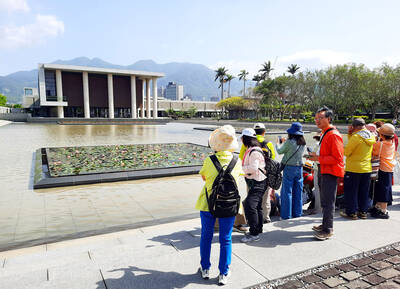
Dull functional structures dominate Taiwan’s cityscapes. But that’s slowly changing, thanks to talented architects and patrons with deep pockets. Since the start of the 21st century, the country has gained several alluring landmark buildings, including the two described below. NUNG CHAN MONASTERY Dharma Drum Mountain (法鼓山, DDM) is one of Taiwan’s most prominent religious organizations. Under the leadership of Buddhist Master Sheng Yen (聖嚴), who died in 2009, it developed into an international Buddhist foundation active in the spiritual, cultural and educational spheres. Since 2005, DDM’s principal base has been its sprawling hillside complex in New Taipei City’s Jinshan District (金山). But